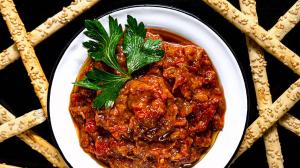Whether you call it shaksouka or tchoukchouka or chakchouka, this preparation has as many variations as it does names and spellings ! Many similar dishes sound the same, include other vegetables and/or meats and could be prepared with chickpeas and shredded flatbreads called chakchoukha or with eggplant called şakşuka. The original version is from the nomadic Berber tribes from North Africa, and over time, it has also travelled and has been adopted by most Arabic, Turkish, Persian, as well as Jewish populations further away, but the original meaning and sound of the word is from the Berber language and simply signifies “mixture”.
Today this preparation is truly Mediterranean, north and south. The most common, well-known and popular use of this preparation today is for simmering whole eggs, directly nestled inside this pre-heated sauce and also called shaksuka. Today, Mediterraneans also simmer eggs in French ratatouille and piperade or Spanish pisto manchego or Tunisian ojja sauces.
This recipe was given to me by my good friend and upstairs neighbor, who is retired now, but who grew up in Morocco, speaks Hebrew as well as Arabic equally well, and moved to France as a teenager.
He calls his version “tchouktchouka “ and it is a simple preparation of equal weights of peppers that are oven-roasted and fresh tomatoes that are parboiled and then peeled, then crushed and simmered to make most of the extra liquids evaporate, to which a touch of garlic is added and then some simple additions of olive oil, salt, pepper, sugar and harissa hot sauce for the last final simmering of everything together to bind the overall flavors.
I modified the methods used for his perfectly tasty recipe, simply because I wanted to add that smoky roasted flavor to all of the main ingredients used and I also wanted to avoid using the stove-top as well as the oven and other extra steps to prepare it. I thought to myself, what would happen if I roasted everything together, sealed in a roasting pan and then simply proceeded with the final assembling of everything ?
It was a simple choice made out of sheer curiosity and I used a large glass roasting pan to observe the progression as well as the results. I weighed everything before and after roasting as well as weighing how much roasted pulp of tomatoes, peppers, shallots and garlic it yielded and then I readjusted everything for a second trial and was extremely satisfied with the results and very happy with the little washing-up required afterwards.
It’s like roasting and smoking the vegetables (with the blackening of the skins) which increases their flavors while reducing their water content. And please don’t be surprised how over 2 kg of raw ingredients will yield only 500 grams of finished sauce in the end ! This is the law of heat and evaporation and what happens when only the pulpy and more intense essence of the foods is left behind !
Any adjustments and/or modifications to the flavors occur after the roasted pulps of everything are mixed together. I also add an interesting leftover of this roasted preparation which is that dark smoked liquid that accumulates on the bottom of the baking dish, of which I use some for an extra roasted and smoky aroma.
I do appreciate how the olive oil and the extra spices and flavorings that are added and mixed in at the end, are not reheated again and shine through differently in the end result. All you need to do is let things sit for a while at room temperature for all those flavors to delicately blend together and then serve it directly or refrigerate the mixture for later.
It’s a summery preparation, that I prefer to enjoy outside, as a chilled dipping sauce with flatbreads or breadsticks, whether in the garden, at a picnic or on a beach, on a hot, dry and sunny day, with perhaps a slight breeze and quite definitely surrounded by the smiling faces and laughter of a few close friends … :)









